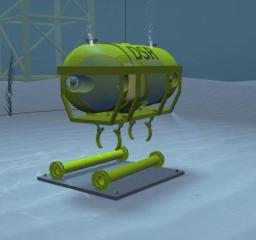ROVAR - BB and ROVAR - WB
ROVAR controllable Buoyancy Beam and Wet Basket
Smarter Subsea Handling continue to develop product lines using the ROVAR variable and controllable buoyancy system which is at the heart of all our Products. In the context of specific customer challenges, we have now developed two new product designs to aid with the removal of pipeline bundles and remediation of seabed habitats in the oil and gas sector, and the handling of cables, pipelines and umbilicals during installation and IRM across multiple underwater sectors .
Adapted subsea 'wet baskets' with integral buoyancy caissons (ROVAR-WB) are deployed as ‘seabed trailers’ and then moved laterally to the required seabed position by a master ROVAR unit. They are suitable for wet lay-down in multiple scenarios for hub and spoke operations. The ROVAR master unit acts as a ‘subsea truck’ in shunt or tow modes.
The ROVAR Buoyancy Beam (ROVAR-BB) is deployed to handle and spread the load of long structures such as pipeline bundles, cables, umbilicals and tubulars. These can be recovered to, or deployed from, our subsea baskets, which in turn can be connected to ROVAR ‘trucks’.
Buoyancy is generated in both structures which are then raised to the surface for recovery to semi-submersible barge or by back-deck crane.
Smarter Subsea Handling has developed two specific pipeline bundles recovery solutions utilising ROVAR-BB and ROVAR-WB:
- Cutting into c.20m lengths and placing into ROVAR-WBs (wet baskets) for transfer to barge, or
- Cutting into lengths of c.100m by ROVAR-BBs for chained tug tow to coastal recycle ports.
Background and Opportunity
As of 2022, there are around 87 pipeline bundles, with a total length of 315km in UK waters. The longest bundle is 7.7km in length and the largest bundle is 1.5m diameter, with 80% of bundles less than 1m diameter.
OPRED (Offshore Petroleum Regulator for Environment and Decommissioning) requires operators to submit decommissioning plans for all pipeline bundles in the UK North Sea.
OPRED has mandated that the abandonment of seabed surface pipeline bundles “in-situ” shall not be approved, and a “clear-seabed” policy is required.
Removal Options
Pipeline bundles were manufactured at coastal sites and towed by construction support vessels to their oil & gas destination, thereafter flooded to the seabed.
The reverse of the install method is not possible as the outer shells of most bundles have integrity issues, and reverse reel onto pipelay vessels would result in uncontrolled sectioning of the bundles.
The options available to the industry are to trench, or to cut and recycle to surface.
Wet Basket and Cutting Solution
The Wet Basket and Cutting Solution has ROVAR in two complementary configurations, with one ROVAR-BB unit operating as a cutting and handling beam for c.20m pipeline sections, and another ROVAR-WB unit operating as a controllable buoyant wet basket.
The operating sequence would be for the cutting beam to segment c.20m sections and handle them into the ROVAR-WBs, which would then be floated to the surface for transfer to a submersible barge and subsequent tug tow to land.
Chained Tow and Cutting Solution
The Chained Tow solution would section longer bundle lengths for tug tow to the coastal recycle yards and would therefore not use buoyant wet baskets submersible barges.
This solution would use three ROVAR-BB cutting and lifting units to section a c.100m length of pipeline bundle, stop or crimp the ends of the pipeline sections and then lift them to the splashzone. The ROVAR-BB cutting unit would remain on-location to continue sectioning.
Once at the splashzone, conventional modular fixed buoyancy units would be fitted to each section and then multiple chain-linked sections would be tug towed to coastal recycle yards.
On arrival at the yards, the chained length would be lifted by quayside crane for processing and recycle.
| Specification Title | Specification Description |
|---|---|
|
Caissons
|
Open bottomed GRP buoyancy caissons form main sections of buoyancy beam, or wet basket, each of which can be independently controlled
|
|
Gasification System and Liquid Nitrogen (LIN) Dewar
|
Actuated cryogenic control valves, LIN flow through heat exchange piping exposed to sea water, deballasts caissons with actuated relief valves controlling retention and release of gas, activated by Master ROVAR units connected to ROVAR-BB or ROVAR-WB
|
|
Control System
|
Hardware and software provided by Master ROVAR units
|
|
Sensors and ancillary equipment
|
Depth/Pressure, sonar (distance to seabed and other obstructions), gyros, lights, cameras, navigation
|
Reviews
Sign up or log in to your explorer or platform subscription to get access to the reviews written about this technology.
The Technology Readiness Level (TRL) indicates the maturity level of novel technologies. Learn more about the TRL scale used by us.
[5/9]




